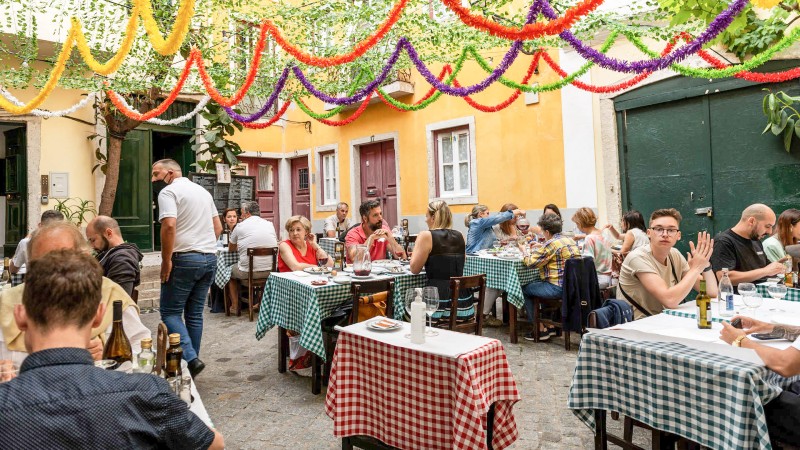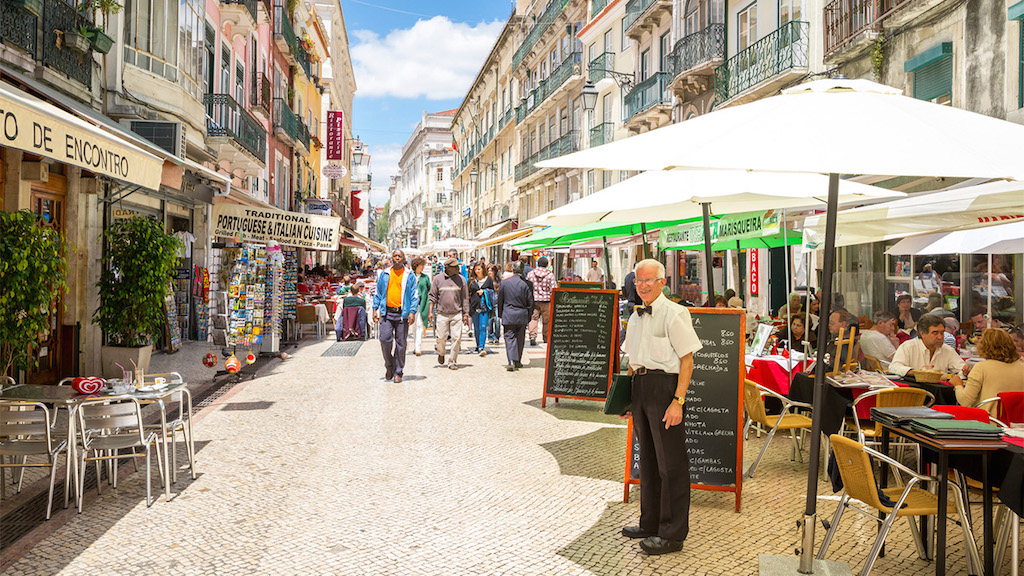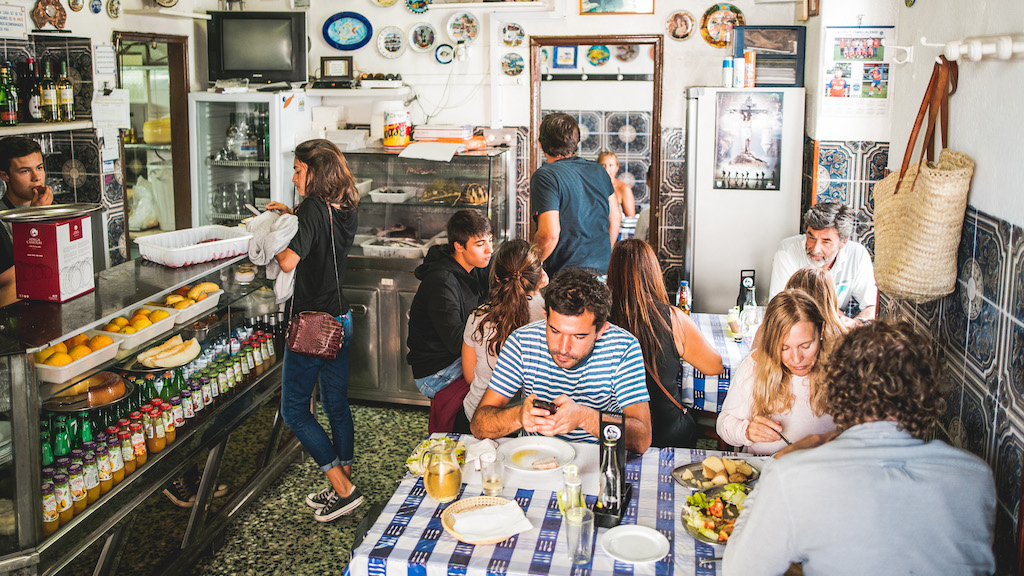How to tell if a restaurant in Lisbon is authentic

When we talk about the intrinsic connection between food, its place of origin, and the people who cook it and eat it, it’s important to acknowledge traditions and a certain dose of authenticity.

The adjective authentic refers to something that has a clearly defined origin. Even though we are fans of fusion cuisine and contemporary interpretations of traditional recipes, we will not stand for establishments that serve low quality products or dishes that seem to have an identity crisis, labeling them as typical, genuine or authentic, for the sake of attracting tourists.
If, like us, you believe that gastronomic integrity lies at the core of authenticity, we have some pointers for you on how to navigate Lisbon’s restaurant scene, so that you can simply sit down and enjoy a proper Portuguese meal.
These are our best tips to spot truly authentic Portuguese restaurants in and around Lisbon:
Touristic streets = touristic restaurants
We start with a rather obvious tip, that makes sense in Lisbon as much as it does anywhere else in the world with high tourist influx. When you look for a place to eat in a highly touristic area, usually downtown, chances are you’ll end up spending your money at a place where quality or authenticity aren’t the core values. It makes sense when you come to think about it: in touristic areas, there are no repeat customers. You go to a restaurant once, maybe twice, during your holidays, and then you go back home. Therefore, businesses don’t need to put much effort into delighting you to the point of making you a repeat customer.
Here in Lisbon, the higher concentration of restaurants that cater to tourists happens in the downtown area of Baixa, specially in the streets of Rua Augusta, Rua dos Coreeiros, and Rua Portas de Santo Antão. We are not claiming that there aren’t worthy establishments around here, of course. But you do have to be a little more careful around these areas if you want to eat a proper Portuguese meal, that is, one that not only tastes good but that is also representative of the local food culture.

No need for a waiter to lure you in…
It is precisely in these kinds of areas where you will more often see waiters on the street, with menus in hand, trying to persuade you to take a seat and order a meal at the restaurant they work for. They will normally focus on having representative dishes or offering good value for money, but this is frequently questionable.
Too many flags in the menu is not a good sign
Waiter-advertisers and menus translated into a big range of languages often go hand in hand. And what goes best with a menu that leaves no tourist lost in translation? Big flags of their countries, so that travelers don’t feel excluded. These can be in the menus themselves or, in an even flashier fashion, in boards outside restaurants, sometimes even partially blocking the sidewalks, advertising the restaurants’ star dishes or daily specials with photos which colors the strong sun of Lisbon tends to help fade away over time.
A typical Portuguese restaurant does NOT serve paella
If there is something that has great potential of annoying a local in Portugal is when visitors say gracias instead of obrigado, as if there was no difference between the languages of Spain and Portugal. The food equivalent of this mindset would be wondering where you can eat the best paella in town. Indeed you can find this rice and seafood dish in Lisbon, but if you’re truly looking to eat something local and traditional, our saucier version of seafood rice, known in Portuguese as arroz de marisco, is the dish that you should keep in mind.
In very touristic areas, you will sometimes see paella advertised in the menus and boards outside restaurants. Instead of putting effort into promoting local dishes that travelers may or may not know about, some businesses prefer to “give the customer what the customer wants”, thus making a fuss about paella platters that are very often pre-cooked. So, as we were saying, an authentic Portuguese restaurant will serve arroz de marisco over paella and, in the cases when you do find paella in the menu of a good local restaurant, more often than not as a daily special and not so much as part of the permanent menu, it will probably be called arroz à Valenciana.

You will not eat “the best sardines in Lisbon” during cold months
Grilled sardines are one of Lisbon’s quintessential dishes. As such, it’s only normal that travelers are eager to try them. Fresh sardines are seasonal food, available in the late spring and summer. Locals are so yearning for sardine season that when the fish is finally available during warmer months, you will see it in menus all over town. In fact, during the Lisbon festivities in June, the smell of charcoal-grilled sardines takes over the most historical neighborhoods of the city, where makeshift outdoor grills and bars are installed for people to eat out and party.
So if you are walking around a touristic area of Lisbon during the colder months and waiters try to seduce you into their restaurants advertising delicious sardines, please keep in mind that the fish will most likely be frozen. Fresh sardines always taste best, with succulent flesh and grilled skin until it gets crispy and smokey from the grill. Frozen sardines are also perfectly edible, of course, but no one should say they are the best, as they will not represent the fish and the dish to their full potential, and may because of that end up being disappointing. If you want to eat sardines during winter, we’d recommend opting for high quality canned seafood.
Eggs and bacon? No! Portuguese breakfast is coffee, bread and pastries.
We understand that Lisbon restaurants and cafés are eager to cater to the desires of international travelers and this often means adapting their offerings to the hungry expectations of those who visit us. There’s nothing wrong with that, of course. It’s fine to serve eggs, bacon and beans for breakfast, but we don’t think it’s OK to call it a “portuguese breakfast”, just because you add a pastel de nata on the side. When you start naming things in a way that benefits your business, and not so much referring to what they really are, the traditional concepts start getting diluted and you end up with chefs such as Gordon Ramsay making an Iberian pork and eggs skillet and calling it a Portuguese breakfast.
The ratio of local and international diners matters
This applies to Portugal and anywhere else in the world: if you see that the majority of people eating at a given restaurant is local (or of the country of origin that the restaurant represents), chances are the food is good. No one will be more critical of Portuguese food than Portuguese people, so if you see a lot of Lisbon folks approve of the restaurant, this will work as a seal of authenticity and you can be rest assured that the meals served are what they are supposed to be.

If these observations apply to all ranges of Portuguese restaurants in Lisbon, we have even more tips for you, on how to spot a real tasca. These are the Portuguese version of taverns, no-frills establishments that focus on drinks, snacks and some typical dishes, usually served in an unpretentious and delicious way.
Joining our food & cultural walks in Lisbon and following our tips, we hope you get to experience the most genuine side of our city, our people, and our food culture. If you need further information or advice, we’re always happy to chat with you via Instagram or Facebook. Please tg us: @tasteoflisboa #tasteoflisboa.
Feed your curiosity on Portuguese food culture:
How to identify an authentic Portuguese Tasca
Best restaurants to eat contemporary Portuguese food in Lisbon
Itinerary for the perfect weekend in Lisbon
Day trips from Lisbon that we locals also enjoy
Real people, real food. Come with us to where the locals go.
Signup for our natively curated food & cultural experiences.
Follow us for more at Instagram, Twitter e Youtube
